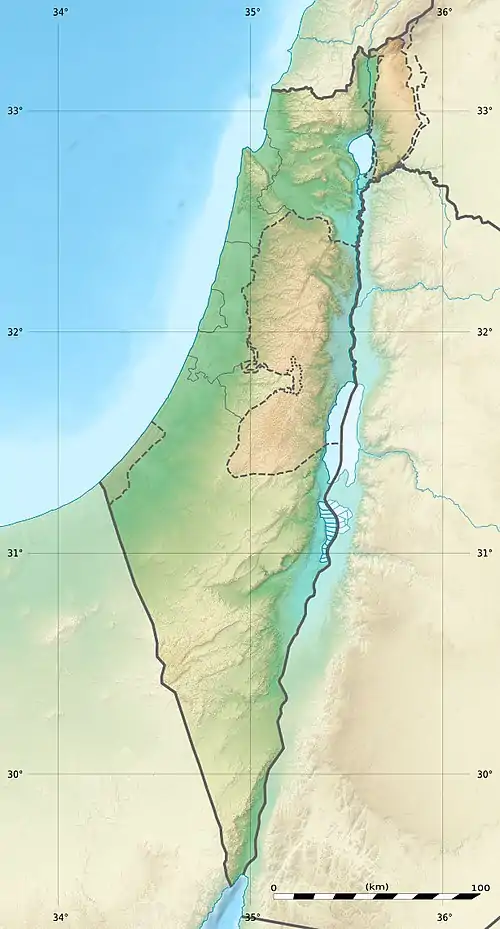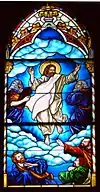Marriage at Cana
The transformation of water into wine at the Marriage at Cana or Wedding at Cana is the first miracle attributed to Jesus in the Gospel of John.[1][2] In the Gospel account, Jesus, his mother and his disciples are invited to a wedding, and when the wine runs out, Jesus delivers a sign of his divinity by turning water into wine.
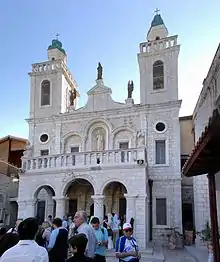
The location of Cana has been subject to debate among biblical scholars and archaeologists; multiple villages in Galilee are possible candidates.
Biblical account
John 2:1–11 states that Jesus was at a wedding (Seudat Nissuin) in Cana with his disciples. Jesus' mother (unnamed in John's Gospel) told Jesus, "They have no wine," and Jesus replied, "Oh Woman, what has this to do with me? My hour has not yet come." His mother then said to the servants, "Do whatever he tells you" (John 2:3–5). Jesus ordered the servants to fill containers with water and to draw out some and take it to the chief steward (waiter). After tasting it, without knowing where it came from, the steward remarked to the bridegroom that he had departed from the custom of serving the best wine first by serving it last (John 2:6–10). John adds that: "Jesus did this, the first of his signs, in Cana of Galilee, and it revealed his glory; and his disciples believed in him" (John 2:11).
Interpretation
The Wedding Feast takes place in Cana shortly after the call of Philip and Nathanael. According to John 21:2, Cana was Nathanael's hometown.[3]
Although none of the synoptic Gospels mentions the marriage at Cana, Christian tradition based on John 2:11 holds that this is the first public miracle of Jesus.[4] It is considered to have symbolic importance as the first of the seven signs in the Gospel of John by which Jesus' divine status is attested, and around which the gospel is structured. Jesus will later return to Cana, where John 4:46-54 describes him healing a Capernaum official's young son; the second sign in John's Gospel.[3]
The story has had considerable importance in the development of Christian pastoral theology. Fulton J. Sheen thought that it is very likely that it was one of Mary's relatives who was being married. This would mean Mary and her relatives would be embarrassed if they appeared inhospitable by running out of wine, giving Mary a reason to ask Jesus to intervene. Sheen further suggests that as Jesus showed up with additional guests, they may have contributed to the wines running short.[5] When his mother advises Jesus that their hosts are running out of wine, he says "Woman, what has this to do with me?" Sheen sees an echo of the Protevangelium of Genesis 3:15 "I will put enmity between you and the woman, and between your offspring and hers", marking the commencement of Jesus' redemptive ministry.[5] Jesus will again address her as "Woman" in John 19:26, when he entrusts his mother to his disciple John, "“Woman, behold, your son.”[3]
The gospel account of Jesus being invited to a marriage, attending, and using his divine power to save the celebrations from disaster are taken as evidence of his approval for marriage and earthly celebrations. It has also been used as an argument against Christian teetotalism.[6]
Interpreted allegorically, the good news and hope implied by the story are in the words of the steward of the Feast when he tasted the good wine, "Everyone serves the good wine first, and then the inferior wine after the guests have become drunk. But you have kept the good wine until now" (John 2:10, RSV). This could be interpreted by saying simply that it is always darkest before the dawn, but good things are on the way. The more usual interpretation, however, is that this is a reference to the appearance of Jesus, whom the author of the Fourth Gospel regards as being himself "the good wine".[7] According to Bill Day, the miracle may also be interpreted as the antitype of Moses' first public miracle of changing water (the Nile river) into blood. This would establish a symbolic link between Moses as the first saviour of the Jews through their escape from Egypt and Jesus as the spiritual saviour of all people.[8]
Some commentators have speculated about the identity of the unnamed bridegroom. One tradition, represented by Thomas Aquinas among others, holds that the bridegroom was St John the Evangelist himself. Bishop John Spong suggests in his book Born of a Woman that the event was the wedding of Jesus himself to Mary Magdalene.[9] In 1854, at a time when polygamy was an element of mainstream practice of The Church of Jesus Christ of Latter-day Saints, the Latter-day Saint elder Orson Hyde made a similar suggestion, arguing that Jesus was a polygamist and that the event at Cana was his wedding to Mary Magdalene, Martha and Mary of Bethany.[10][11][12]
Geography and archaeology
The exact location of "Cana in Galilee" (Greek: Κανὰ τῆς Γαλιλαίας, Kana tēs Galilaias) has been subject to debate among scholars.[13] Modern scholars maintain that since the Gospel of John was addressed to Jewish Christians of the time, it isn't likely that the evangelist would mention a place that did not exist.
Locations which are candidates for historical Cana are:
- Kafr Kanna, in Galilee
- Khirbet Qana, also called Kenet-l-Jalil, also in Galilee
- Ain Qana, Southern Lebanon
- Qana, Southern Lebanon.[14]
According to the Catholic Encyclopedia of 1914, a tradition dating back to the 8th century identifies Cana with the modern Arab town of Kafr Kanna, in Galilee, about 7 km (4.3 mi) northeast of Nazareth, Israel.[15] Other suggested alternatives include the ruined village of Khirbet Qana, also called Kenet-l-Jalil, about 9 km (5.6 mi) further north, and Ain Qana, in Southern Lebanon, which is considered to be a better candidate on etymological grounds. Some Lebanese Christians, especially Lebanese Maronites, believe the southern Lebanese village of Qana to have been the actual location of this event.[16]
In the journal Biblical Archaeological Review, Michael Homan argues that many biblical scholars have misinterpreted early texts, translating to 'wine' when the more sensible translation is 'beer'.[17] However, this has been dismissed by other writers, who point out that the Greek oinos always means wine, and that the word sikera was available if the gospel author wanted to refer to barley beer.[18][19][20]
In art
Depictions of Marriage at Cana are numerous in art history.
- Marriage at Cana in art
 Marriage at Cana, c. 1500, Gerard David, Musée du Louvre, Paris
Marriage at Cana, c. 1500, Gerard David, Musée du Louvre, Paris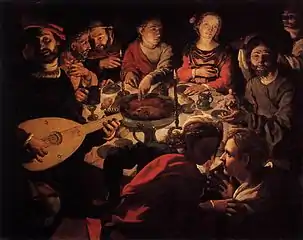 The calling of Apostle John at the Marriage at Cana, c. 1530, Jan Cornelisz Vermeyen
The calling of Apostle John at the Marriage at Cana, c. 1530, Jan Cornelisz Vermeyen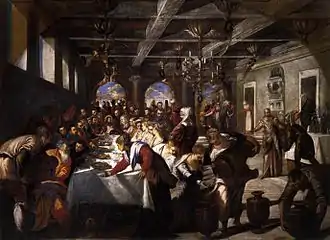 Marriage at Cana, 1561, Jacopo Tintoretto
Marriage at Cana, 1561, Jacopo Tintoretto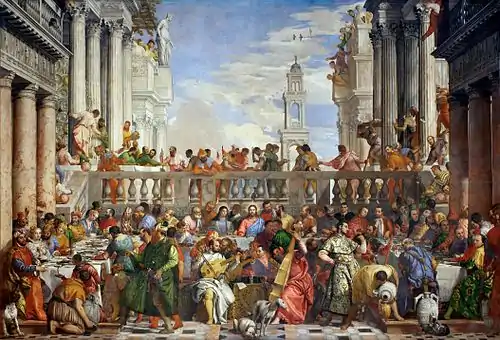
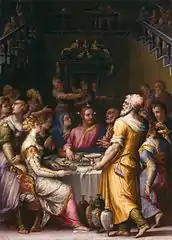 Marriage at Cana, 1566, Giorgio Vasari
Marriage at Cana, 1566, Giorgio Vasari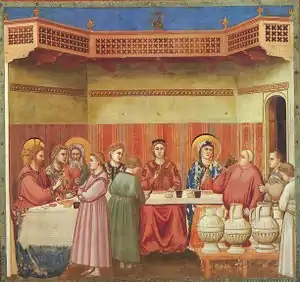 Marriage at Cana by Giotto di Bondone, 14th century
Marriage at Cana by Giotto di Bondone, 14th century Print about the Marriage at Cana. Made at the end of the 16th century. Preserved in the Ghent University Library.[21]
Print about the Marriage at Cana. Made at the end of the 16th century. Preserved in the Ghent University Library.[21]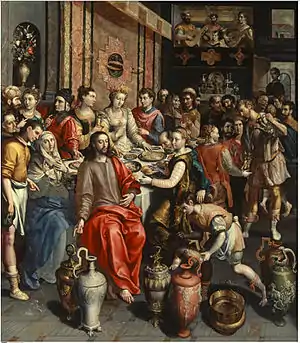 The Marriage at Cana by Maerten de Vos, c. 1596
The Marriage at Cana by Maerten de Vos, c. 1596
Other
Saint Columba of Iona supposedly performed an identical miracle when he served as a deacon in Ireland under Finnian of Movilla, replenishing the supply of sacramental wine for a Mass.[22]
References
- Hendrik van der Loos (1965). The Miracles Of Jesus. Brill Archive. p. 590. GGKEY:ZY15HUEX1RJ.
- Royster, Dmitri (1999). The Miracles of Christ. St Vladimir's Seminary Press. p. 71. ISBN 978-0-88141-193-5.
- Winstanley, Michael T. (2008). Symbols and Spirituality: Reflecting on John's Gospel. Don Bosco Publications. pp. 8–. ISBN 978-0-9555654-0-3.
- Towner, W. S. (1996), Wedding, in P. J. Achtermeier (Ed.), Harper Collins Bible Dictionary (pp. 1205-1206), San Francisco: Harper
- Sheen, Fulton J. (1952). "The Marriage Feast At Cana, in The World's First Love". www.catholictradition.org.
- e.g. Geisler, N. L. (1982), A Christian Perspective on Wine-Drinking, Bibliotheca Sacra, 49
- e.g. Smith, D. M. (1988), John, in Mays, J. L. (Ed.), Harper's Bible Commentary (pp. 1044-1076), San Francisco: Harper.
- Day, Bill, The Moses Connection in John's Gospel, Mariner Publishing (1997) ISBN 0-9662080-0-5
- John Shelby Spong, Born of a Woman (Harper, 1992) pages 187-199.
- Orson Hyde, Conference message, October 6, 1854, Journal of Discourses 2:82
- Inside Today's Mormonism by Richard Abanes 2007 ISBN 0-7369-1968-6 page 239
- A Disparity in Doctrine and Theology by E Roberts 2011 ISBN 1-4497-1210-X page 54
- Jesus and archaeology by James H. Charlesworth 2006 ISBN 0-8028-4880-X pages 540-541
- Eerdmans Dictionary of the Bible 2000 ISBN 90-5356-503-5 page 212
- "Catholic encyclopedia: Cana". Newadvent.org. 1908-11-01. Retrieved 2012-05-16.
- "Lebanese Town Lays Claim To Jesus Christ's First Miracle", Associated Press, January 12, 1994.
- Homan, Michael M. “Did the Ancient Israelites Drink Beer?.” Biblical Archaeology Review, Sep/Oct 2010.
- Kneale, Stephen (November 23, 2016). "Did Jesus actually turn water into beer?". Building Jerusalem.
- Rao, Bandari Prabhakar (April 14, 2010). The Missiological Motifs of the Miracles of Jesus Christ. ISPCK. ISBN 9788184650259 – via Google Books.
- Saarnivaara, Uuras (April 29, 2008). Can the Bible Be Trusted?: Old and New Testament Introduction and Interpretation. Wipf and Stock Publishers. ISBN 9781556356995 – via Google Books.
- "Bruiloft te Kana". lib.ugent.be. Retrieved 2020-09-28.
- Adomnan of Iona. Life of St Columba. Penguin books, 1995
External links
| Wikimedia Commons has media related to Marriage at Cana. |
Marriage at Cana | ||
| Preceded by Return of Jesus to Galilee |
New Testament Events |
Succeeded by Jesus and Nicodemus John 03:01–21 |
